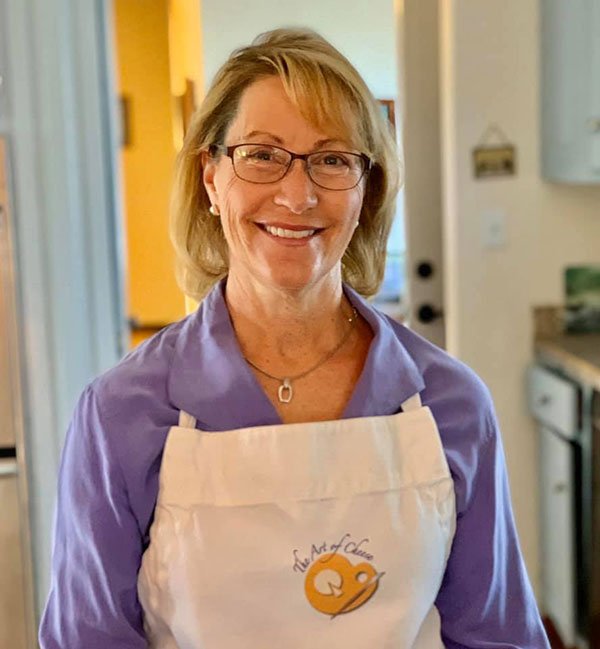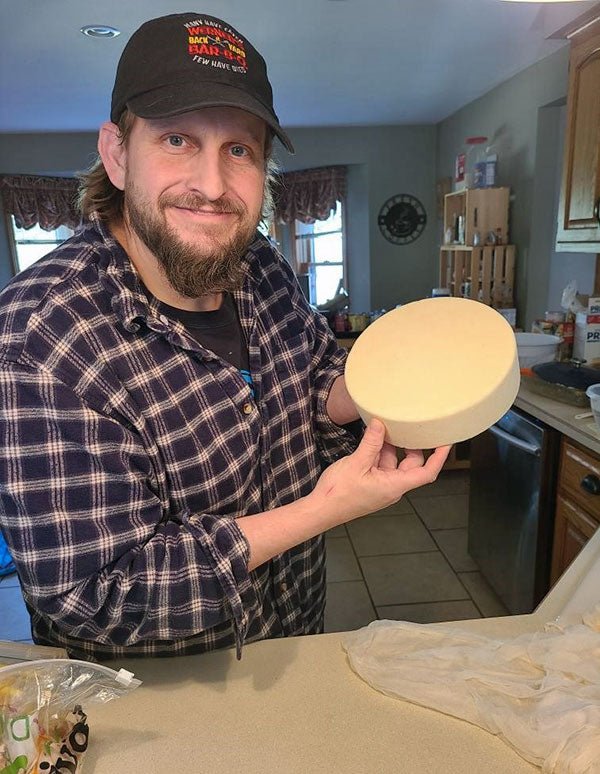
Cindy Johnston
This interview supports our theory that cheese makers are the most interesting people in the world. They just are.
Cindy Johnston is accomplishing more in her retirement than many of us do in our entire lives (at least it seems that way). She is definitely accomplishing more cheese making!

Cindy’s Story
I grew up on a farm in Lancaster County, Pennsylvania and now live a hour away in Lebanon county on 4.5 acres which consists of some open land and a large wooded area. I am surrounded by Amish and Mennonite farmers which explains how I have access to a wonderful supply of milk.


My rain garden during July. I had a fledgling black vulture live at my house for 2 weeks. It used to sit on my roof or swing set and watch me grill. (A little unnerving.) It still comes back and will do low circles over my head.
I retired in July from Lebanon Valley College, Annville, PA where I spent 29 years in the chemistry department. I taught freshman chemistry lab and Introductory Science for Education majors and non-science majors.
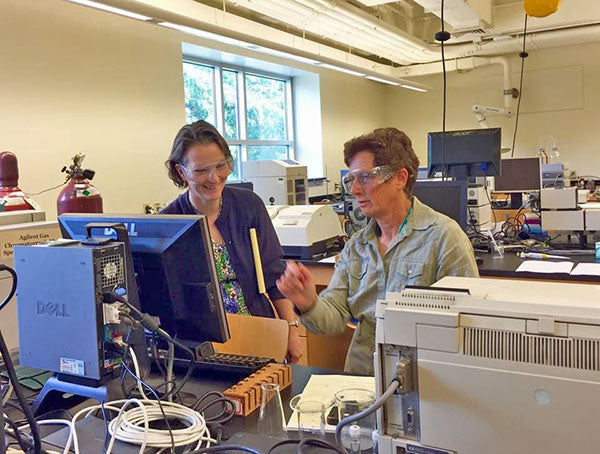
With Cindy Dora, a colleague
I am surrounded by Amish and Mennonite farmers which explains how I have access to a wonderful supply of milk.

Christmas cheese board
My introduction to cheese making was in 2006. A craft store in Annville had a one day workshop that had participants make feta, 30 minute mozzarella, ricotta and queso blanco cheeses. We all got to take home what we had made.
I was hooked and continued to make the feta and mozzarella on a consistent basis. At that workshop, we were introduced to New England Cheesemaking Supply Co. and I started looking at all of the great recipes, but was too intimidated to attempt any of the cheeses that had additional cooking steps, a mold or a press.
But in a few years, I was making enough feta and mozzarella that I advanced from buying the individual packets of cultures to the bulk packets of culture. So, I had enough cultures to experiment with other cheeses.
My first molded cheese was Jim’s Canestrato basket cheese because no fancy mold or press was needed. Although this cheese was tasty, it really wasn’t the cheese I wanted. I wanted to make gouda, cheddar, swiss, blue, all cheeses that aren’t rated as “beginner.”

Canestrato basket cheese in brine

Basket cheese made from yogurt
Finally, in the fall of 2015, I signed up for an online class to make gouda. I made a press.

Pressing beer cheese.
I bought the small hard cheese molds. I bought a wine cooler to use as a cheese cave.

I made the gouda with the class. Suddenly, seeing the process live made cheese making so much easier. I needed to make more cheese.
My first solo cheese was a chocolate stout beer cheese made using my daughter-in-law’s home-brew and Jim’s recipe. It was delicious.

Chocolate beer cheese curds

Beer cheese
I found a source of goat milk so I was off making chèvre, tomme (an aged goat milk cheese recipe), manchego, etc.

Goat tomme
But my dream was to make a soft blue cheese. This one really terrified me, but on March 3, 2016, I bit the bullet, pulled out Jim’s recipe for Gorgonzola Dolce and made myself a nice wheel of cheese.
One month later, the cheese cracked and began oozing. In the end, fed this cheese to the pig because it was a disaster. I consulted with Jim and he said the curds were probably not dry enough before going into the mold.
Gorgonzola disaster:

Day 1

Day 6

Day 8

Day 11

Leaking

Melting
I had no choice but to try again. Now four years later, I make a killer blue cheese. But of course now Jim has introduced the recipe Blue by You, which I immediately made and I love that one too. Slightly different flavor and texture.

Blue cheese
I took Jim’s 201 Workshop in 2016 and again, this was an eye-opener. He shared so many tips that are just never available on a printed page.

St. Nectaire curds

St. Nectaire after 12 hours

White mold starting



Hot pepper, made with Santa Fe peppers
When I took the workshop with Jim Wallace, I met Sue Brinenton and we became “cheese making buddies.” Sue lives in Maryland and in 2019 invited me to join her in the cheese competition at the Maryland Area Ag fair. I entered three cheeses – camembert, blue and asiago.
Each cheese won first place (although the camembert shared first place with an herbed chèvre) and the blue won the best of show. This was so rewarding, not because I won, but because I discovered that people who didn’t need to avoid hurting my feelings liked my cheeses.
Because I wanted more details on the individual cultures and their effects on the cheeses I also attended a cheese making workshop presented by Penn State that explored the science of cheese making.
Another quest was making the perfect pizza mozzarella. I decided I needed to move from the acid process (30 minute) to the cultured mozzarella.

No one should ever suggest that mozzarella is a beginner’s cheese. This cheese is so challenging until you figure it out. My mozzarella was ok, but lacking depth. I took a tour/introduction to mozzarella at Caputo Brothers Creamery in York, PA.
The class was a very superficial introduction to making mozzarella, but when I explained that I was searching for the secret to making “melty” cheese, Ryan gave me some pointers and my mozzarella quest was almost fulfilled. I just needed to find higher quality milk.
Luckily I live in “farm country.” I found a supplier of raw Jersey milk which makes the best cultured mozzarella ever.

I make the mozzarella to the point of passing the stretch test, then I slice it into approximately half pound portions that I partially freeze on a cookie sheet before vacuum packing to be frozen until needed. After thawing, the curds are stretched and the mozzarella is ready to go. (I read this in one of Jim’s mozzarella recipes.)

Jersey milk mozzarella
I fell in love with making camembert, camblue, and bloomy chèvre.

Bloomy chevre.

Bloomy chevre cut.

Pyramid bloomy chevre

Pyramid bloomy chevre cut
I decided I needed to start making aged cheese so I tackled asiago, dunlop, prima donna, and aged gouda.

Gouda
I look forward to the monthly Moos-letter recipes. I just made the warped cheddar.

Warped cheddar top

This is a beautiful cheese.
One of the best has been the tetilla. This has become one of my go-to cheeses.
My searches for different milks also provided me with a source of ewe milk. I was able to make a sheep gouda and several rounds of Manchego which are aging now.
Buffalo Valley Pastures water buffalo farm mentioned in a recent blog article is only a little over an hour from my home. I have been wanting to tackle water buffalo mozzarella for years, but they are not a common animal, even here in farm country.



In preparation for Christmas, I always look for “different” cheeses. One year it was the Beer Washed Monk, another was the Wesley blueberry and cranberry, this year is going to be the warped cheddar and Mad Elf.

Mad Elf



Chimay monk cheese
Over time, I have purchased larger and larger pots to graduate from 1 gal to 2 gal and finally to 4 gal batches of cheese. I always make 4 gallon batches of the Jersey mozzarella and often of my blue cheese too. When I needed to replace my stove, I invested in a gas (propane) stove so that I’d have better temperature control to make cheese.

Cheese equipment
My collection of cheese molds has expanded and I now have two cheese presses and a nice collection of weights. My son’s bedroom has been converted to the press room where I can adjust the heat to press cheese. I keep my house temperature at 60F, but will heat his room to 74 when necessary.

I realized in September that my 3 wine coolers were filled to capacity with cheeses and I still needed to make the holiday cheeses, so I purchased a full-sized freezerless refrigerator for the 54F cheese cave and moved it into Matt’s room. All of my bloomies and blues are in this large wine cooler.

Making cheese has become an obsession. But when someone bites into a homemade cheese and their face lights up with delight, its all worth the effort. My son (Matt) who lives in Philadelphia no longer buys feta or mozzarella cheese at DiBruno’s. He says he’s so used to mine that their cheeses can’t compare.
He and his wife (Elizabeth) live in Glenside, PA. They and their friends are the main recipients of my cheese because they are willing to eat the more flavorful cheeses.

In Puerto Rico with my son, his wife and a dragon-lava cake
Matt has made it his mission to grow the perfect hot pepper for hot pepper cheese. He is cross pollinating Sante Fe peppers with habaneros and scorpions.

Matt with his peppers.
In Lebanon County, Swiss, American, Pepperjack and Cheddar are the favorites. I’m working to convert tastes of a few, but its hard work when blue cheese is considered exotic. Heaven forbid you offer a bloomy.

Goals:
As far as future thoughts on cheese making, I still want to know more about the cultures and their effects on the cheese – more than the basics of meso and thermo. I want to know about the speed of pH change, flavor, etc. What makes MA 4002 better than MM 100. The nitty gritty.
I also need to experiment and learn more about aging processes – again, more of the science behind the practices. Someday when Covid has ended, I want to attend Jim’s class on aging cheeses.
I would, at some point, like to teach people to make cheese. The problem here in PA is the food safety laws are difficult to meet for a very small-scale cottage industry license. I don’t want to make cheese to sell, so the financial outcomes are difficult because there are no “community kitchens” for sharing in this area.
Other hobbies:
I read a lot. According to the library, I have saved $17,337 borrowing books over the years since they moved to their new checkout system.
I grew up on a farm so I always gardened, preserved foods, made bread and all of those kinds of things. I still make jellies and dry fruits and peppers (for cheese of course).

Jelly and dried fruit

Chevre ravioli

Molding the ravioli

The peppers are grown by my son who, as stated earlier, is into cross pollinating plants to produce the perfect cheese pepper.
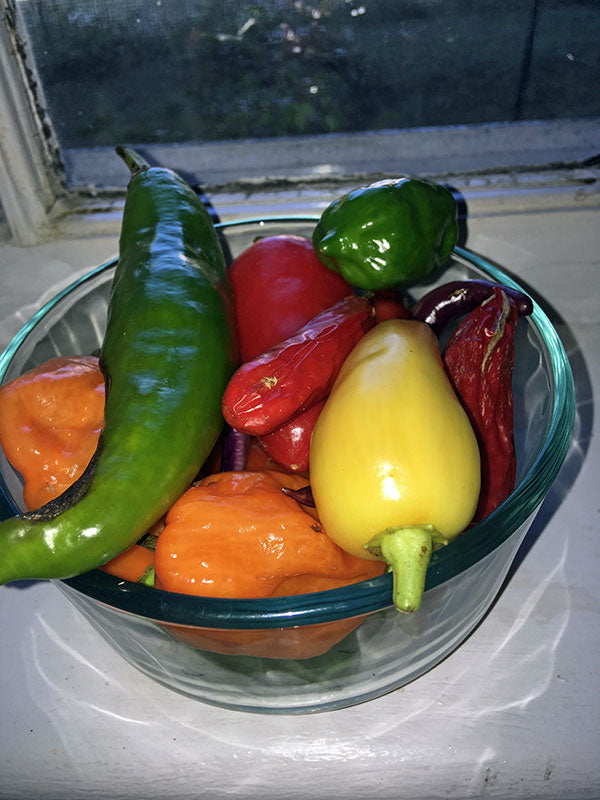
Matt’s peppers

I have a degree in horticulture from Harrisburg Area Community College. Every March, I convert my spare bedroom into a plant starting area and start vegetable and flowers for my sister, myself and my son.
In the summer, I garden a few vegetables, but mostly have pollinator areas for butterflies and other insects. I spend a lot of time taking photos of these insects.

Tiger swallowtails

Milkweed caterpillars
When I was in Belize, I was assigned my very own bodyguard to follow me as I was trying (unsuccessfully) to take photos of the blue morphos. I bore people with endless photos of caterpillars, butterflies and spiders.

A yellow spider, face front
Many hours of my week are usually spent at the local Tae Kwon Do studio. I have been practicing for 30 years and am a 6th degree (Master) blackbelt. I teach several classes there. (Far fewer hours spent there since Covid and restrictions on class sizes and mask wearing.)

Kung-San-Goon, 2020

Nice punch November 1st

Our new belts
I love to travel and have been to Africa three times (Zimbabwe, Botswana, and Kenya), Costa Rica, Belize, Mexico, Australia, Italy, Greece, Puerto Rico. Not to mention camping in National Parks in several states including Maryland, North Carolina, Utah, New Mexico and Arizona. My trips to Africa were all tent safaris.

With guides in Kenya

Kenya Frank
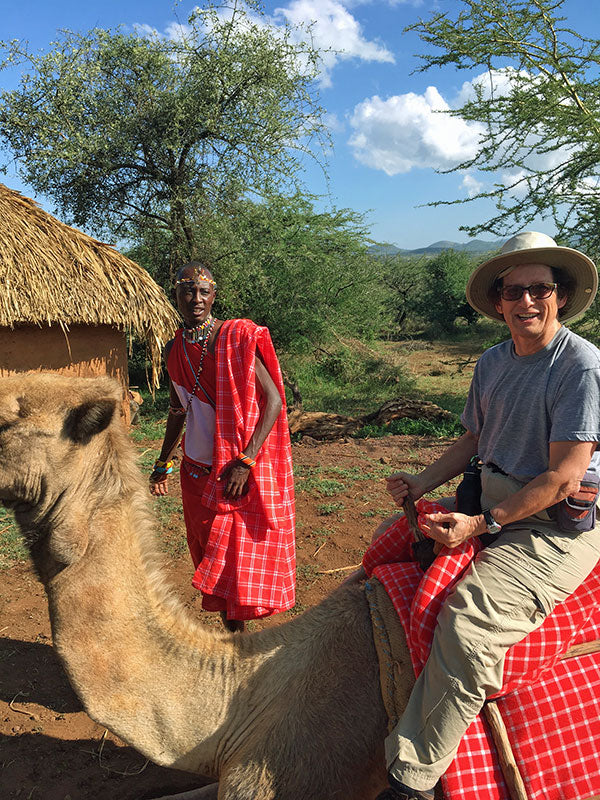
Mounting a camel in Kenya

Top of Tikal in Belize

Sunset in Belize


































